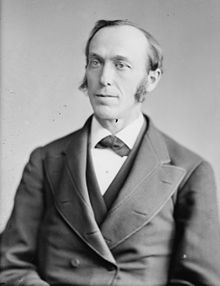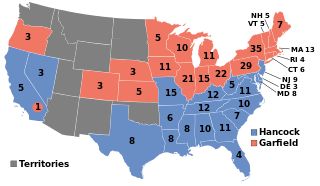
The 1880 United States presidential election was the 24th quadrennial presidential election, held on Tuesday, November 2, 1880, in which Republican nominee James A. Garfield defeated Winfield Scott Hancock of the Democratic Party. The voter turnout rate was one of the highest in the nation's history. Garfield was assassinated during his first year in office, and he was succeeded by his vice president, Chester A. Arthur.

Levi Parsons Morton was the 22nd vice president of the United States from 1889 to 1893. He also served as United States ambassador to France, as a U.S. representative from New York, and as the 31st governor of New York.

The Stalwarts were a faction of the Republican Party that existed briefly in the United States during and after Reconstruction and the Gilded Age during the 1870s and 1880s. Led by U.S. Senator Roscoe Conkling—also known as "Lord Roscoe"—Stalwarts were sometimes called Conklingites. Other notable Stalwarts included Benjamin Wade, Charles J. Folger, George C. Gorham, Chester A. Arthur, Thomas C. Platt, and Leonidas C. Houk. The faction favored Ulysses S. Grant, the eighteenth President of the United States (1869–1877), running for a third term in the 1880 United States presidential election.
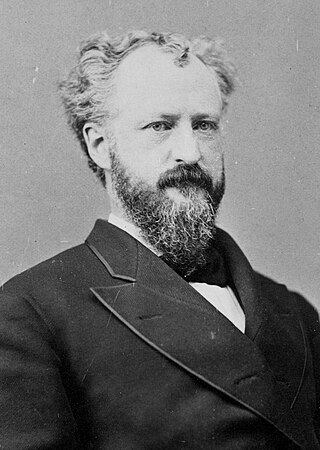
Roscoe Conkling was an American lawyer and Republican politician who represented New York in the United States House of Representatives and the United States Senate.

Thomas Collier Platt, also known as Tom Platt and Easy Boss, was an American politician who was a two-term member of the U.S. House of Representatives (1873–1877) and a three-term U.S. Senator from New York in 1881 and 1897 to 1909. He is best known as the "political boss" of the Republican Party in New York State in the late 19th century and early 20th century. Upon his death, the New York Times stated that "no man ever exercised less influence in the Senate or the House of Representatives than he," but "no man ever exercised more power as a political leader." He considered himself the "political godfather" of many Republican governors of the state, including Theodore Roosevelt.

William Henry Robertson, also known as W. H. Robertson, was an American lawyer and politician from New York.
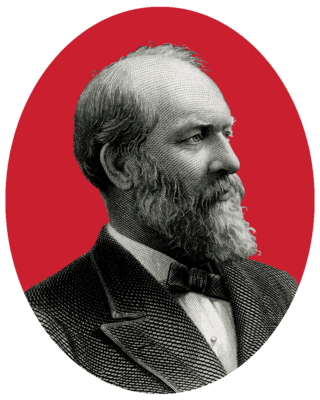
The 1880 Republican National Convention convened from June 2 to June 8, 1880, at the Interstate Exposition Building in Chicago, Illinois, United States. Delegates nominated James A. Garfield of Ohio and Chester A. Arthur of New York as the official Republican Party candidates for president and vice president in the 1880 presidential election.
The "Half-Breeds" were a political faction of the United States Republican Party in the late 19th century.
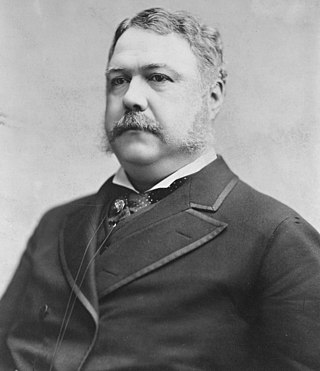
Chester A. Arthur's tenure as the 21st president of the United States began on September 19, 1881, when he succeeded to the presidency upon the assassination of President James A. Garfield, and ended on March 4, 1885. Arthur, a Republican, had been vice president for 199 days when he succeeded to the presidency. In ill health and lacking the full support of his party by the end of his term, Arthur made only a token effort for the Republican presidential nomination in the 1884 presidential election. He was succeeded by Democrat Grover Cleveland.

Chester Alan Arthur was an American politician who served as the 21st president of the United States from 1881 to 1885. He was a Republican lawyer from New York who briefly served as the 20th vice president under President James A. Garfield. Arthur assumed the presidency after Garfield's death on September 19, 1881, and served the remainder of his term until March 4, 1885.

The 1867 United States Senate election in New York was held on January 15, 1867, by the New York State Legislature to elect a U.S. Senator to represent the State of New York in the United States Senate. Incumbent Senator Ira Harris was not renominated for a second term in office. U.S. Representative Roscoe Conkling was elected to succeed him.

The 1873 United States Senate election in New York was held on January 21, 1873, by the New York State Legislature to elect a U.S. Senator to represent the State of New York in the United States Senate.

The 1879 United States Senate election in New York was held on January 21, 1879, by the New York State Legislature to elect a U.S. Senator to represent the State of New York in the United States Senate.

The 1881 United States Senate election in New York was held on January 18, 1881, by the New York State Legislature to elect a U.S. Senator to represent the State of New York in the United States Senate.
The 1881 United States Senate special elections in New York was held from May 31 to July 22 by the New York State Legislature to elect two U.S. senators to represent New York in the United States Senate. The elections were triggered by the May 16 resignations of Senators Roscoe Conkling and Thomas C. Platt, triggered by ongoing disputes with President James A. Garfield over federal patronage privileges in the state, particularly the lucrative postings at the New York Customs House. The resignations were intended to trigger the Senators' re-elections to affirm their support in the New York Legislature as a show of either popularity or political force. Instead, the legislature demurred for 52 days before electing Warner Miller and Elbridge Lapham in their place. During the balloting, President Garfield was shot; he died two months after balloting concluded.
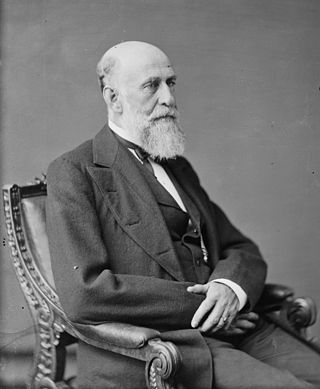
George Franklin Edmunds was an American attorney and Republican politician who represented the state of Vermont in the United States Senate from 1866 to 1891. He was a candidate for the Republican presidential nomination in 1880 and 1884 as a leading representative of New England and of the faction favoring civil service reform.

The 104th New York State Legislature, consisting of the New York State Senate and the New York State Assembly, met from January 4 to July 23, 1881, during the second year of Alonzo B. Cornell's governorship, in Albany.

Louis Frisbie Payn was an American manufacturer and politician from New York. A Republican, he was most prominent for serving as United States Marshal for the Southern District of New York from 1887 to 1881 and Superintendent of the New York State Insurance Department from 1897 to 1900.

The Blaine faction, also known as the Blaine section, was a political organization of Republicans in the United States during the presidency of Rutherford B. Hayes who coalesced around Maine U.S. senator James G. Blaine. Forming a coalition with the conservative Stalwart wing during the era, they opposed civil service reform, as well as the conciliatory actions of the Hayes administration towards the South. Blaine himself would vote with Stalwarts in opposition to President Hayes' reform efforts, siding with Conkling's faction in December 1877 when voting against the nomination of Theodore Roosevelt Sr., to become New York Custom of Collectors.
The Cameron machine, later known as the Quay machine and Penrose machine, was a Republican political machine in Pennsylvania that controlled much of the state's politics for seven decades. Founded by antislavery Know Nothing and Republican Simon Cameron, it passed into control of his son J. Donald Cameron, later controlled by Matthew Quay and finally Boies Penrose. The organization was financially and fiscally conservative, favoring higher protective tariffs and representing business interests.
